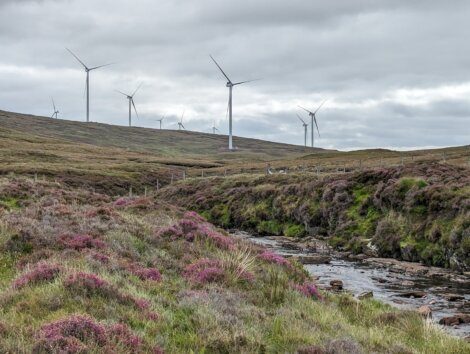Council / Councillors approve principles for community benefit negotiations
The principles cover onshore and offshore wind projects as well as hydrogen and carbon capture
SHETLAND councillors have backed a new set of principles around community benefit which will be used in future negotiations with energy developers.
One proposal is for five per cent of gross net revenue from future onshore wind developments to go back to the community, which would mark a considerable and more profitable shift from existing schemes.
There is also a recommendation for 2.5 per cent of gross revenue from hydrogen projects – a sector which is not yet active in Shetland but could come on council land in the future, such as in Scatsta.
It is understood an item on Scatsta later went in front of elected members in private at the same meeting of the full Shetland Islands Council (SIC) on Monday.
Although the community benefit principles were approved at the full council meeting, the wording was changed following a successful amendment from environment and transport committee chair Moraig Lyall.
She proposed to remove a clause which said particular community benefit approaches would be pursued “where full or partial ownership has been assessed as not viable or desirable”.
Lyall expressed concern this clause could have potentially created delays to negotiations over community benefit.
Her amendment also included instructing officers to develop the other recommendations included in a report from consultants Aquatera, which was made in conjunction with Voar and Community Energy Scotland.
The amendment – which won a vote against Gary Robinson’s motion to approve the recommendation as originally suggested – also included extra wording to make it clear that there was an endorsement of community benefit being index-linked, so it would rise with inflation.
The report presented to elected members said there is “real potential for Shetland Islands Council to shape the future of community benefits in Scotland and the UK through bold policies and leadership and sharing these widely, to create new benchmarks for what best practice can look like”.
Become a member of Shetland News
It covered onshore wind, floating offshore wind, hydrogen and carbon capture – all sectors which are mooted for Shetland and its surrounding seas.
The recommendation for onshore wind community benefit is five per cent of the gross project revenue, and a minimum payment of £7,300 per MW a year.
If the revenue recommendation was hypothetically applied to the divisive 103-turbine Viking wind farm – which went live last year – then it is thought that over £7 million would come Shetland’s way in the form of community benefit, more than three times the current level.
The suggested minimum payment is also greater than the £5,000 per MW industry benchmark which the Viking community fund receives from developer SSE Renewables.
For floating offshore wind there is a recommendation to pursue 2.5 per cent of gross revenue, and £5,000 per MW a year, which is based off equivalent payments for a development off the Isle of Lewis.
It is recommended that this 2.5 per cent share also applies to other future energy developments such as hydrogen and carbon capture and storage, with the minimum payments to be decided.
Councillors approved incorporating these principles into Shetland’s energy strategy for negotiations with developers.
The study aimed to “consider whether community benefit models from energy developments are currently achieving policy aims and delivering a fair share for Shetland, or whether a new and locally specific approach is required”.
There are some existing community benefit schemes in Shetland from renewables, with the £2.2 million-a-year Viking fund the largest.
But the proposed principle of having community returns linked to revenue would represent a major change in direction.
Coincidentally the five per cent idea has already been floated by the Scottish Liberal Democrats.
With many energy projects in the pipeline, there are plenty of unknowns around future community benefit for Shetland.
There are Statkraft’s three planned wind farms in Yell and the outskirts of Lerwick, as well as two large offshore developments proposed to the east of Shetland.
But there are also new energy proposals in Shetland outside of wind, such as hydrogen production at Scatsta plus Sullom Voe Terminal.
The report on community benefit was introduced at Monday’s meeting by SIC economic development manager Tommy Coutts.
It came off the back of a net zero taskforce which was set up in Shetland after councillors rejected a first draft of an energy strategy for the islands amid criticism that it lacked vision.
Coutts said there was a desire to see Shetland get a “fair share” from energy developments.
He highlighted that community benefit remains a voluntary practice, although he said there is good practice at play.
When asked by councillor Allison Duncan if community benefit negotiations with energy developers could fail, chief executive Maggie Sandison suggested companies are keen to take the community with them.
“Ultimately when you’ve got a voluntary agreement there is always a chance that a voluntary agreement isn’t made,” she said – but because developers have shown understanding over working with communities, the ability to negotiate is “strong”.
In the report’s conclusion, it suggested that the “quality of Shetland’s wind resource and development sites means that SIC can afford to take a robust line, with a low risk of turning developers away”.
Coutts also said the recommendations in the report were “considered to be those which are achievable within the margins”.
But he said it was essential for a “flexible and pragmatic” approach to be applied during community benefit negotiations.
Coutts added that the principles should set out the local expectation for a “fair return” for Shetland.
At Monday’s meeting there was no real pushback against the specific proposals for community benefit principles – with any dissent shown coming against particular wording rather than the numbers.
However SIC depute leader Gary Robinson expressed concern over the viability of hydrogen production at “any point in the near future”.
Although there were a number of recommendations in the report, Coutts said the community benefit one had been prioritised.
Sandison also said there were some things in the report that “we as officers would not be recommending to you”.
She said some of the recommendations would need additional legal and financial advice.
Council leader Emma Macdonald sought to reassure members, though, that some of the other areas covered in the report were already being explored by the SIC.
The topic of the council having ownership in energy developments was also brought up in discussion but finance manager Paul Fraser said the SIC is essentially precluded from borrowing to directly invest.
Meanwhile Green councillor Alex Armitage said he felt the energy transition should involve the transfer of control “from corporations to the people”.
He said his message governments and energy corporations was that “we are a strong community that will always put the needs of our people first”.
Armitage added it “it doesn’t cost anything to have ambition”.
However North Isles councillor Duncan Anderson expressed “alarm” over the impact future energy development could have on existing industries as well as the environment; there is concern, for example, over the impact offshore wind farms could have on the fishing sector.
Anderson said the council would have “little or no say” regarding the development of offshore wind.
But he said it would be “remiss of us” not to try to obtain community benefit from the projects which go ahead.
During debate Lyall also said she personally would take the view that there should be a presumption against further large scale development on land where there is not considerable community ownership.
“Personally I would want us to speak out against any further industrial scale onshore wind,” she said.
One of the recommendations in the report was that the SIC “could” consider a presumption against further large onshore developments “unless these demonstrate a significant degree of community ownership”.
But Lyall – who said there was a hope that a revised energy strategy would be presented to councillors this side of summer – said she acknowledged that certain decisions are not councillors to make, and that as a planning authority the SIC needs to make decisions which stand up legally.
Development committee chair Dennis Leask also advocated being “ambitious” in negotiations with developers.
Meanwhile Robinson said he considered that community benefit “as a whole has to be balanced against the price we pay for our electricity”.
“Community benefit doesn’t come from some special place that doesn’t cost energy customers,” he said.
Become a member of Shetland News
Shetland News is asking its many readers to consider paying for membership to get additional features and services: -
- Remove non-local ads;
- Bookmark posts to read later;
- Exclusive curated weekly newsletter;
- Hide membership messages;
- Comments open for discussion.
If you appreciate what we do and feel strongly about impartial local journalism, then please become a member of Shetland News by either making a single payment, or setting up a monthly, quarterly or yearly subscription.



















































































